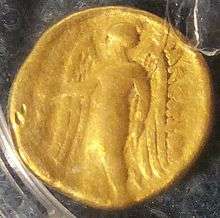Anartes

The Anartes [1] a.k.a. Anarti, Anartii or Anartoi [1] were Celtic tribes, or, in the case of those sub-groups of Anartes which penetrated the ancient region of Dacia (roughly mod. Romania), Celts culturally assimilated by the Dacians.[2][3]
Ptolemy's Geographia locates the Anartoi in Dacia.[4][5] Some groups of Anartes occupied parts of modern Slovakia and southeastern Poland.[6]
The Dacian town of Docidava was situated in the territory of the Anartes, according to Pârvan.[7]
The Anartophracti (or Anartofraktoi) are mentioned by Ptolemy. This tribe's name appears to be compound Latin-Greek name and may be related to the Anartoi resident in Dacia, Czarnecki argues.[4] The Anartofraktoi were a northern Dacian tribe, according to Braune[8][9] or mixed Dacian-Celtic, according to Pârvan.[10]
In ancient sources, the earliest mention of the Anartes is in the Elogium of Tusculum (10 BC).[11]
In De Bello Gallico, an account of his own campaigns in the Gallic Wars (58-51 BC), Julius Caesar wrote (VI.25.1): "The Hercynian Forest begins in the territories of the Helvetii, Nemeti and Rauraci and stretches, for a distance of 9 days' journey for a fast traveler, along the Danube as far as the borders of the Daci and the Anartes".
Around AD 172, the Anartes refused to assist the Romans in their war against the Marcomanni. To punish them, the Roman emperor Marcus Aurelius ordered the deportation of (all?) the Anartes from their native homelands to the Roman province of Pannonia Inferior, a movement which took place not later than AD 180.
Archaeological evidence
The Anartes were probably identical with, or constituted a significant part of, the archaeological Púchov culture in Slovakia, which included the centres of Zemplín, Bükkszentlászló and Galish-Lovačka[12] During the late La Tène period, mixed settlements of Celts and Dacians spread over the eastern Slovak lowlands with Zemplin at its center, according to Husovska.[13] According to Ioana Oltean, archaeological excavation has revealed that some Celtic tribes (Anartes, Teurisci) had migrated eastwards as far as Transylvania, where they were eventually assimilated by the Dacians.[2] Even though some groups of Anartes advanced as far as the Transylvanian plateau, the main area of their domination was to the West of it, Macrea & Filip argue.[14]

Sources
- Archeologie Barbaru. 2005, [in:] Ján Beljak. Puchowska kultura a Germani na pohroni v starsej dobe rimskej. pp. 257–272
- The Works of Tacitus. by Alfred John Church and William Jackson Brodribb[15]
- Czarnecki Jan (1975) "The Goths in ancient Poland: a study on the historical geography of the Oder-Vistula region during the first two centuries of our era, University of Miami Press"
- Macrea and Filip Jan (1970) "Actes du VIIe Congrés International des Sciences Prehistoriques et Protohistoriques", Prague published by the "Institut d'Archéologie de l'Académie" Prague
- Oltean Ioana A (2007) Dacia: Landscape, Colonization and Romanization, ISBN 0-415-41252-8, 2007
- Schutte, Gudmund (1917) Ptolemy's maps of northern Europe: a reconstruction of the prototypes, (1 ed.), publisher H. Hagerup
- Parvan, Vasile (1926). ‘’Getica. Cvltvra naţională, Bucvreşti.
Notes
- 1 2 Jan Czarnecki (1975) 120
- 1 2 Oltean Ioana A (2007) 47
- ↑ Parvan & 1926 222-223 and 461-462.
- 1 2 Jan Czarnecki (1975) 119
- ↑ Ioana A Oltean (2007) Dacia: Landscape, Colonization and Romanization, ISBN 0-415-41252-8, 2007, page 47
- ↑ "It is possible to separate the group of La Tène culture (Celtic settlement) in the Upper Tisza Basin. For the time being there are circa 160 sites noted. They can be divided into several distinct categories which include the following: settlements, production areas, sepulchral sites, i. e. burial grounds and single graves as well as various hoards (deposits of coins and tools). Moreover, there are three oppida: Zemplin, Bükkszentlászló and Galish-Lovačka. The chronology of the whole group lies between LT B1-LT D1/D2. Especially interesting is the problem of correspondence between this group and the group of sites in southeast Poland. Material connections are also documented in ancient sources. They allow to identify the group from the Upper Tisza as the Anarti tribe and the group from southeast Poland as the Anartophracti, which is a part of the former. [in:] Marek Olędzki. "La Tène culture in the Upper Tisza Basin =La Culture de la Tėne dans le Bassin de la Haute Tisza". Ethnographisch-archaeologische Zeitschrift. Berlin. ISSN 0012-7477".
- ↑ Parvan (1926) 749
- ↑ Wilhelm Braune, Hermann Paul, Eduard Sievers (1916)Beiträge zur Geschichte der deutschen Sprache und Literatur, Volume 41, M. Niemeyer
- ↑ Schutte, Gudmund (1917) 99
- ↑ Parvan (1926) 222-223
- ↑ InscrIt_13.3.91
- ↑ La Tène culture in the Upper Tisza Basin. EAZ. Jahrgang 41, 2000 Archived April 20, 2012, at the Wayback Machine.
- ↑ Ludmilá Husovská (1998) “Slovakia: walking through centuries of cities and towns”, Priroda, page 187
- ↑ Macrea and Filip (1970) 893
- ↑ "Below the Venedae are the Gythones, then the Finni, then the Sulones; below whom are the Phrungundiones; then the Avarini near the source of the Vistula river; below these are the Ombrones, then the Anartophracti, then the Burgiones, then the Arsietae, then the Saboci, then the Piengitae and the Biessi near the Carpathian mountains. Among those we have named to the east: below the Venedae are the Galindae, the Sudini, and the Stavani, extending as far as the Alauni; below these are the Igylliones, then the Coestoboci and the Transmontani extending as far as the Peuca mountains."